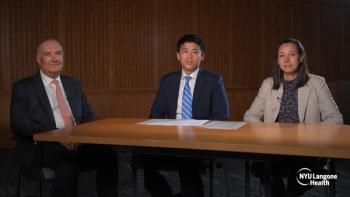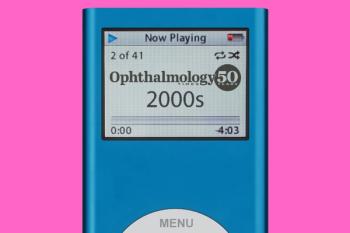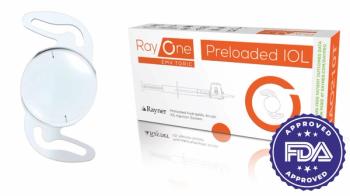
(Podcast) Confronting Demodex blepharitis: From rude awakening to FDA-approved solution
In this podcast episode, Ophthalmology Times' co-chief medical editors Peter J. McDonnell, MD, and Neda Shamie, MD, delve into the clinical nuances of Demodex blepharitis. Through personal anecdotes, they stress its underrecognized gravity and discuss diagnostic cues like collarettes. The experts share their enthusiasm for improved treatments, echoing the transformative impact seen in dry eye care.
Ophthalmology Times' co-chief medical editors Peter J. McDonnell, MD, and Neda Shamie, MD, delve into the clinical nuances of Demodex blepharitis. Through personal anecdotes, they stress its underrecognized gravity and discuss diagnostic cues like collarettes. The experts share their enthusiasm for improved treatments, echoing the transformative impact seen in dry eye care.
The views and perspectives expressed are those of Dr. McDonnell and Dr Shamie.
Editor's note: This transcript has been edited for clarity.
Sheryl Stevenson: Hi, everyone. This is Sheryl Stevenson, group editorial director with Ophthalmology Times®. Welcome to this episode of our EyePod podcast series.
We’re joined today by Ophthalmology Times’ very own co-chief medical editors from the West Coast to the East Coast.
Dr. Peter McDonnell is the director of the Wilmer Eye Institute at Johns Hopkins University School of Medicine in Baltimore, Maryland, and Dr. Neda Shamie is a cataract, LASIK, and corneal surgeon and partner of the Maloney-Shamie Vision Institute in Los Angeles, California, as well as an adjunct clinical professor of ophthalmology at the USC Keck School of Medicine.
In today’s episode, they discuss Demodex blepharitis and its impact on millions of patients, and what a newly FDA-approved treatment will mean for clinicians and their patients.
Dr. McDonnell, start us off!
Peter J. McDonnell, MD: Hi! Welcome to EyePod. I'm Peter McDonnell. And it's my pleasure to be here today with the famous Dr. Neda Shamie and to talk about really an important common and undertreated condition that we see so often in our practices.
Neda, we're recording this just shortly after the tropical storm-hurricane got out there to Los Angeles. So everything's okay out there with you and your family?
Neda Shamie, MD: Yes, everything is perfect. And first of all, thank you so much for having me on this EyePod. I'm really excited to do this with you, Peter, especially since you are the reason I entered into ophthalmology many years ago. You've always been a mentor, a friend, a huge advocate.
And as far as the tropical storm or the California hurricane that we had, I had one or two leaves fall off a tree in our backyard. I think that was very traumatic for us. Jokes aside, there were unfortunately many who were quite affected by it. In our area, thankfully, there wasn't much, and I was a little embarrassed to say even call it a hurricane or a tropical storm with my friends who live in the East Coast who experience much worse such experiences but thank you for asking.
Shamie: I'm excited to talk about Demodex blepharitis. It's something that has been funny enough as a cornea specialist near and dear to my heart. I've been in search of a wonderful treatment option that hopefully would become available to us.
I first noticed...I don't know when was the first time you started really thinking about Demodex blepharitis...for me, it was about 15 years ago. I saw a poster that Scheffer Tseng [MD] presented at ARVO about Demodex blepharitis and how it can really affect the ocular surface. I had a patient [whom] I had done a corneal transplant on and who just could not hold on to his corneal transplants...kept melting his cornea, really severe ocular inflammation. After that ARVO meeting, I came back I plucked a few of his eyelashes. I went and looked under the microscope and saw these live mites living around the follicles of his eyelashes, and at the time started him on a regimen that Scheffer would recommend and was able to help him hold on to his corneal transplants thereafter.
So, for me, it was a rude awakening that it's a real problem that we miss often because we are not looking for it. But thankfully, I think more and more we are being educated and made aware of Demodex blepharitis being such an important problem. And you know, more than 25 million Americans are affected by it. What do you think about this new FDA approval of Xdemby [lotilaner ophthalmic solution 0.25%; Tarsus Pharmaceuticals]?
McDonnell: Well, I think it's exciting for all the reasons you mention. This is a disease that—and it's the most disgusting organism I'm pretty sure that I've ever seen—but it's a disease that's really only become to be appreciated during our careers. We know that these organisms live amongst most, if not, almost all adults to some degree, and they live there and they eat sebum and keratinaceous debris and they're these gross little creatures. In a certain percentage of patients, presumably where there's an excessive population on the lid margins, they can cause very significant pathology as you pointed out.
When I was a resident, the teaching that I got was when you saw these collarettes and these funny little secretions at the lid margins that it was Staph. It made sense because you'd do a culture and grow some Staph as you would any place you culture the skin. But it's thanks to Scheffer Tseng and others, as you pointed out, we've learned that these mites are present and that they can cause significant pathology in people.
To me, it's a lot like when I started out doing dry eye. Not a lot of interest in it. Not much therapy. Once Allergan got the approval with topical cyclosporine and we had an FDA-approved treatment, all of a sudden it really focused the interest of ophthalmologists in diagnosing and treating patients with substantial dry eye. And it essentially created recognition of the disease that affects so many people [with] dry eye disease.
And, as you pointed out, with those staggering numbers of people where the Demodex blepharitis is a factor, it's an important unmet need. So I applaud the people at the company, Tarsus, and I have no relationship with that company, whatsoever, but I applaud them for the persistence that it takes to take a new treatment through the FDA for something for which there's no available treatment. In the old days, we were doing stuff pretty off-label when we had to treat patients with this. To have something that's on label, FDA approved, will I think really be nice, and I'm really looking forward to it been readily available.
Shamie: I absolutely agree that it's going to elevate awareness. What's nice about this is that it's not very difficult to diagnose. Whereas with dry eye, there was a lot of...one of the biggest hurdles was trying to encourage our colleagues to diagnose inflammatory dry eye, and there were so many challenges in really documenting that.
With Demodex blepharitis, all it takes is really for the doctor to have the patient look down and look at the base of the eyelashes and look for the collarettes and the collarettes are pretty pathognomonic for the Demodex. If you see that...often patients describe itching at the eyelid margin; they have ocular surface inflammation; they have meibomian gland disease; they have other inflammatory ocular surface-related symptoms, and if they have Demodex, now with the new FDA-approved eye drop that's a 6-week treatment. It's a really nice kind of treat as you see it and see the response and then kind of go after other layers of inflammation there as there may be.
I am really excited about this. I have a lot of patients who have had chronic kind of relentless blepharitis or meibomian gland disease. It's very common in rosacea patients, and these patients have not responded to any treatment and quite aggressive treatments. I'm excited to try it for my patients. I have a list of patients that are waiting for it. So I think it's going to be available by the end of this month or next month. So it's really around the corner.
McDonnell: It'll be a real opportunity to improve quality of life for so many of our patients. You help out a patient and it may not be the same as doing cataract surgery or whatever, but they'll be grateful and loyal patients, hopefully, going into the future. I think it's wonderful to see this available and for both ophthalmologists and optometrists, I think we'll be able to serve a much larger group of patients. Let's face it, scrubbing with a washcloth, maybe with some baby shampoo will only get you so far. I think the data from the clinical trials that I've seen are pretty convincing that this really is a substantial improvement over the nonspecific treatments we've had before.
Shamie: I think for my refractive surgical patients as well as my cataract surgical patients, I am looking for Demodex because it can affect the ocular surface. It could become...it could be an -itis for inflammation and infection. I am excited to have a kind of a short-treatment course to be able to treat these patients in preparation for surgery. So that, the demographics of patients coming in for surgery, are also the same kind of demographics that tend to have the Demodex blepharitis.
I urge all our colleagues to have the patients look down; look for the collarettes. Now that we have a treatment that's been FDA approved, as you said, I think the onus is on us to find those patients and offer them the treatment that could potentially have a really huge impact on their eye health.
With that, I think we're going to end our EyePod here. This is a lot of fun, Peter. Thank you so much for chatting with me.
McDonnell: Always a pleasure, Neda. Maybe we'll touch base after the launch and see what your real-world experience is with this exciting new therapy.
Shamie: Sounds great. Thank you so much.
Newsletter
Don’t miss out—get Ophthalmology Times updates on the latest clinical advancements and expert interviews, straight to your inbox.






















































.png)


